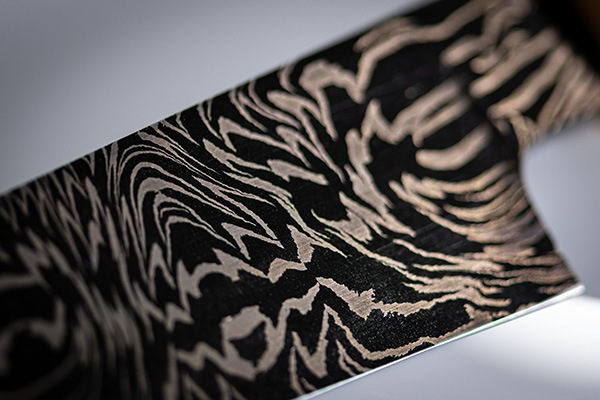Our Damascus steel is made from forge welded layers of 15N20 steel and 1075 steel. The 15N20 is a Nickel steel and is what forms the highlights of the pattern, whilst the 1075 is a Carbon steel and turns black when etched.
When heat treated and used in a blade this combination holds an excellent edge. The blade will gain an attractive patina with prolonged use as with any Carbon steel based blade. The colour and character of the patina is determined by the type of ingredients and food the blade is used to cut. For example, cooked red meat creates a beautiful blue-grey patina that will be familiar to anyone who has encountered heirloom carving knives.
Caring for your blade
Caring for a Damascus steel blade is much the same as for a Carbon steel blade - moisture is the enemy. Once the blade has built up a patina it is much more forgiving, but a fresh Carbon steel based blade will begin to rust in a heartbeat.
Never, ever:
- Leave the blade resting in standing water
- Rest the blade on a damp tea towel, wash cloth, etc
- Store in direct contact with leather
- Wash in a dishwasher
To help your Damascus steel knife become a heirloom, there are only a few things you need to do.
After use:
- Rinse clean under running water and wipe dry with a clean cloth
- Lightly oil using food safe oil
- Store in a dry place
While your blade is still developing a patina, it is a good idea to quickly wipe the blade down before moving on to a food preparation task not involving the knife.
Oiling
A common mistake when oiling a blade is to use something like olive oil that will go rancid. We recommend mineral oil, as it is food safe, cheap, and readily available.
Washing
Many people new to Damascus steel knives approach washing their blades with trepidation. Cleaning your knife is straightforward: rinse it under running water, give it a wipe with a lightly soapy dish sponge, rinse it again and wipe dry. If you’re familiar with the term “Bachelor Wash” (or can decipher the connotation), this is all it takes.
Refreshing the pattern
The Damascus pattern will fade with use - this is normal and easy to rectify. Hot black instant coffee (cheap, nasty, and mixed at a ratio that would kill a large animal) is a mild etchant that we use as the final stage of our Damascus etching process. It is element of our process that contributes most to the blackness of the pattern.
Here’s how to refresh your own blades:
- Brew a batch of the cheapest and nastiest black instant coffee you can get your hands on. You’ll need enough to immerse the blade in.
- Wash the blade, then thoroughly wipe it down with methylated spirits to remove oils and contaminants
- Immerse the blade in the instant coffee, heating the coffee back up if it’s gone cold (heat increases the rate of reaction). Take care to avoid getting coffee on the handle.
- Expect the process to take anywhere between 15 minutes and an hour. Check the blade every 15 minutes by removing it from the coffee and allowing the coffee to drip off. Do not touch or wipe down the blade at any point.
- When the desired results have been achieved, remove the blade from the coffee then wash as normal before oiling and storing.
Questions?
If you ever have any concerns or questions about caring for one of our blades, please do not hesitate to get in touch. Our knives will last for a generation or two when properly cared for and we want you to feel secure in that knowledge. We’re always here to help.
